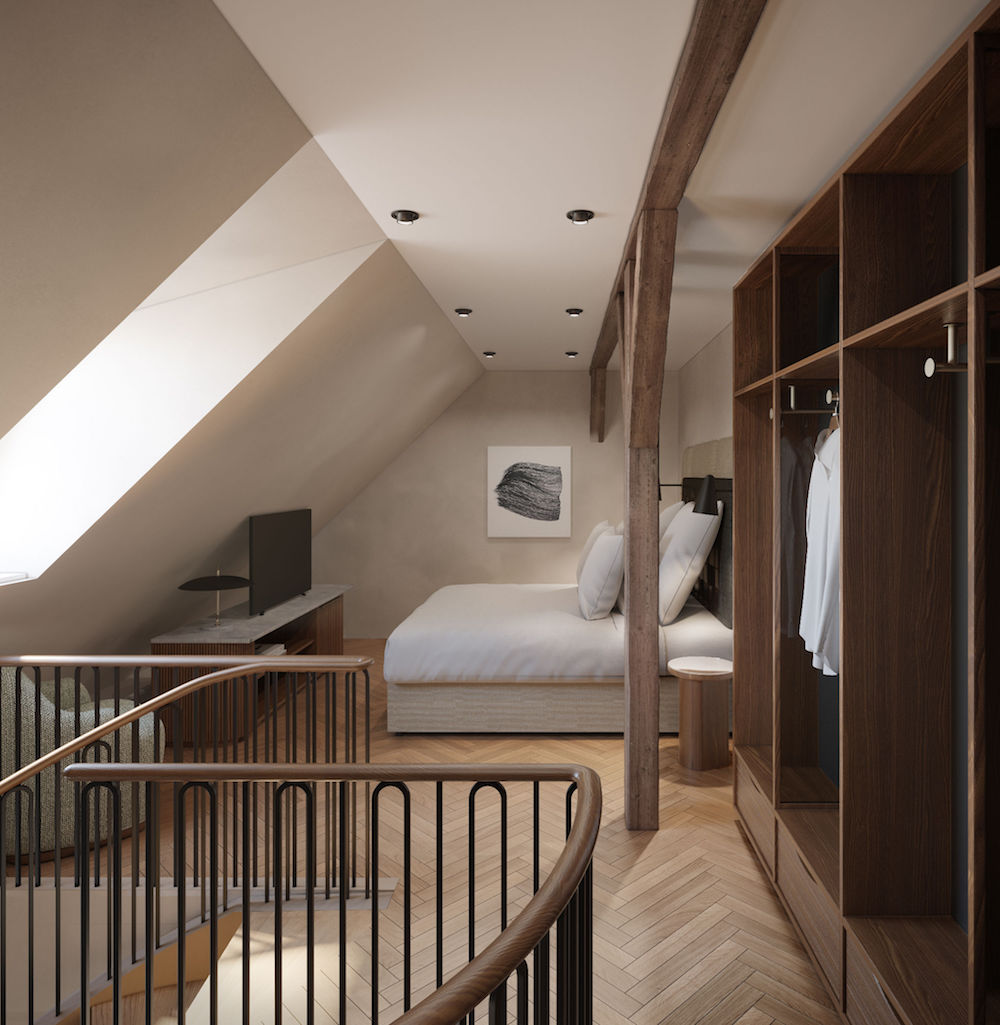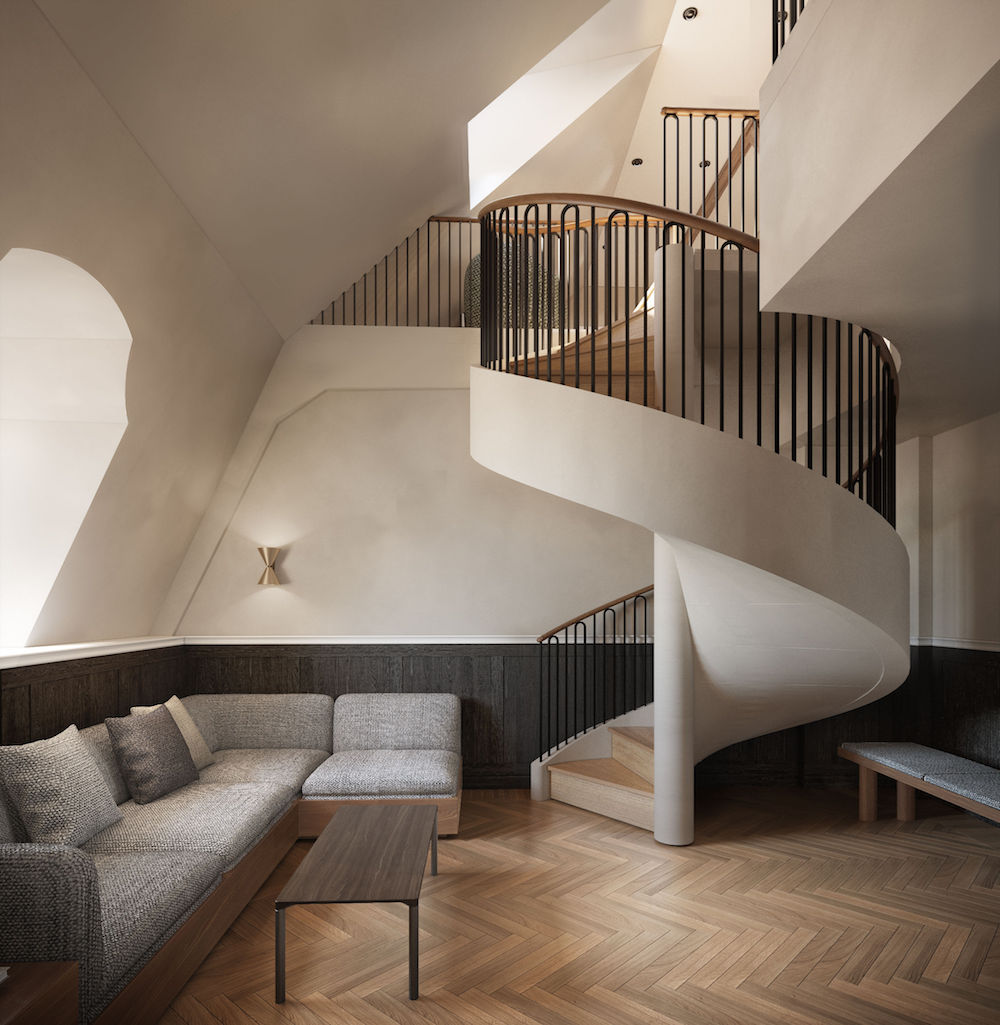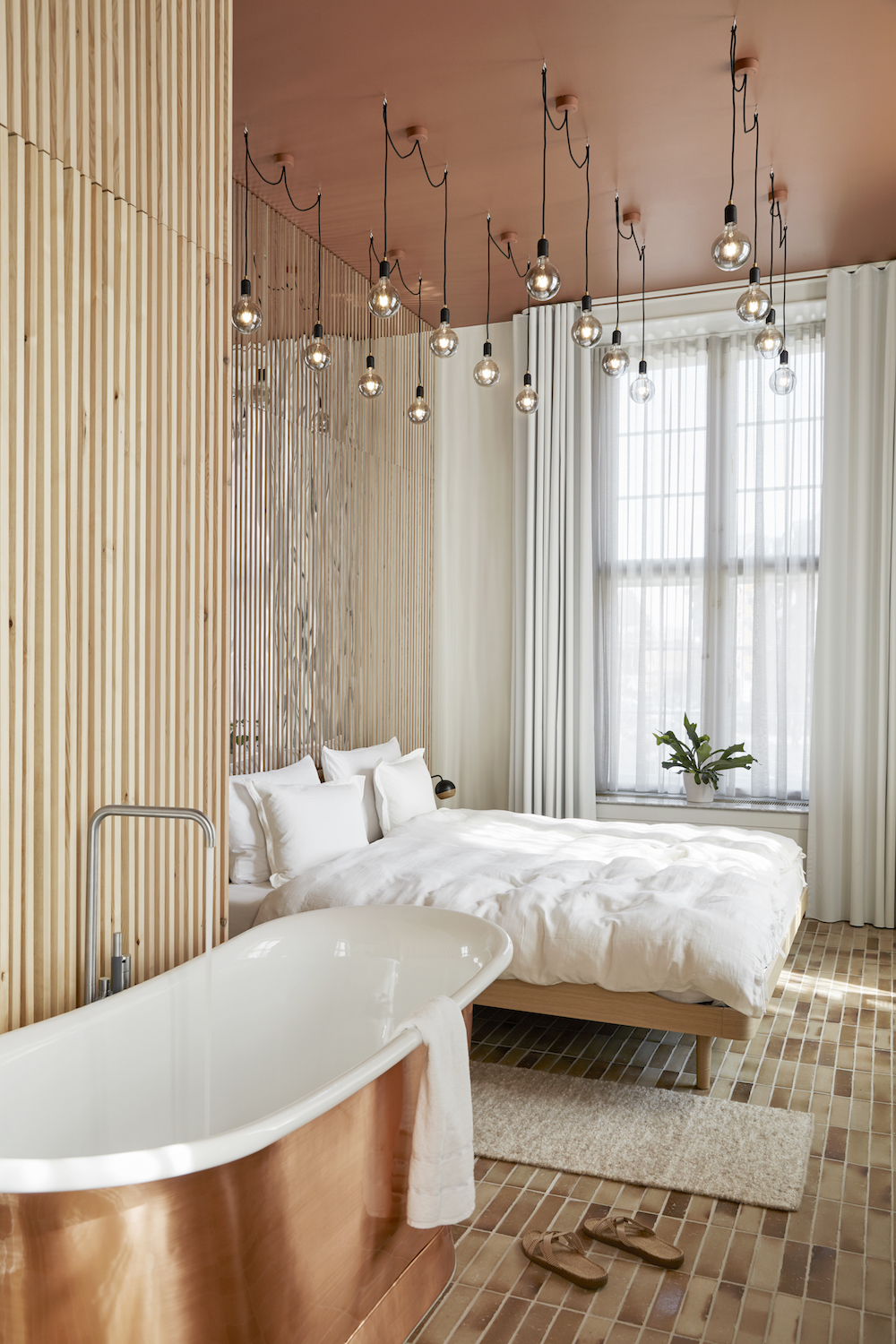A much-anticipated addition to the Danish capital city, Copenhagen, transforms an iconic architectural landmark into a modern oasis of cool. Writer Collette Swindells explores…

It is not often that a space of more than 25,600 square metres becomes available in the centre of a European capital – least of all in a city like Copenhagen, where it is often considered something of a luxury to have a separate shower and toilet in your downtown apartment.
Instantly recognising the tremendous potential of the site, Nordic Hotels & Resort, a member of Preferred Hotels & Resorts, sought to transform the imposing old-world grandeur of the five-floor, Neo-Baroque former headquarters of the Danish Post and Telegraph into a fresh expression of what it means to be Scandinavian.
Combining an impressive roll-call of talents including award-winning London architecture and interiors firm Universal, award-winning design studio Goddard Littlefair, specialist F&B design studio Epicurean, Danish architect Eva Harlou and Nordic jewellery designers Shamballa Jewels, the reconstruction weaves together three key themes of contrast, conscious luxury and happiness.
The arrival experience
Entering the somewhat unassuming frontage, adjacent to the Copenhagen Central Station, guests are immediately greeted with an expansive, light-filled, glass-roofed atrium lobby – appropriately named The Square – centrally adorned by a tongue-in-cheek ‘Whispering’ sculpture from Spanish artist Jaume Plensa.

Image credit: Stine Christiansen
Cleverly designed to be a multi-functional space that welcomes both locals and foreigners, it artfully mixes classic Danish design elements with contemporary flourishes and finishes that unite the functions of the hotel boutique, lounge area, bar, self-service check-in and reception. It is a space that comes alive at night too, with live music and DJs cementing its vibrant personality, and other day-time pop-ups including a mobile piercing station from jeweller Maria Black.
Direct access to most of the hotel’s F&B and public areas is available from The Courtyard, ensuring it is continually an animated, lively thoroughfare and meeting point for all.
Relaxed public areas for all occasions
To the city side of this, The Playroom acts as a further extension of the lobby lounge space, with even more intimate spaces and cosy pockets that encourage visitors to have fun with friends while playing board games, foosball and other table games on custom-made tops. Part grand parlour part secluded den, the space is also perfect for hosting large groups, with Epicurean ensuring a relaxed, cultivated atmosphere with its Carl Hansen furniture, vintage tiling, antique-style woodwork and panelling and patina mirrored walls.
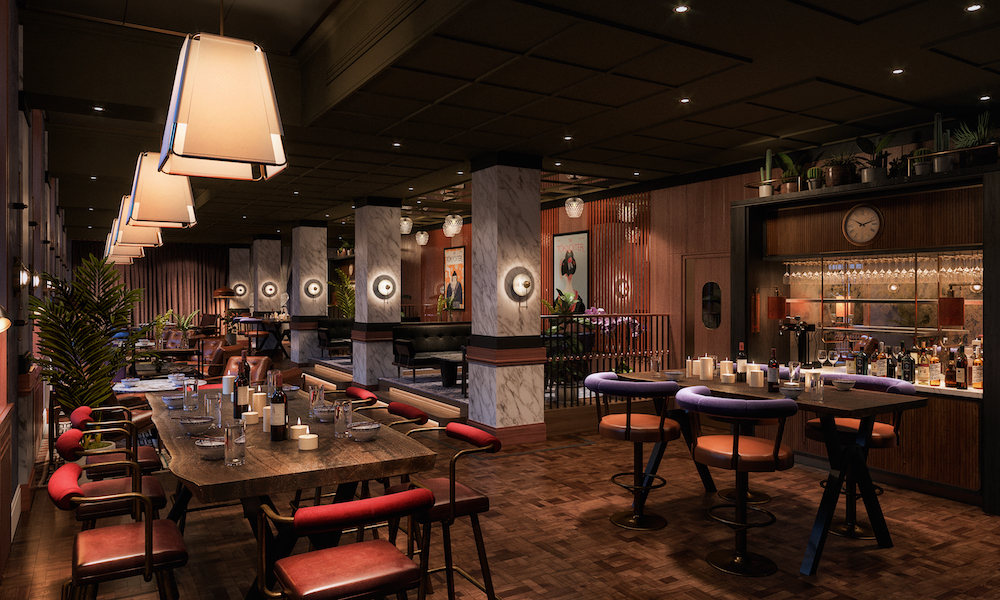
Image caption: The Playroom | Image credit: Villa Copenhagen
On the alternate side of The Courtyard, Kontrast, a contemporary brasserie, offers an equally smart take on mid-century styling, with subtle tributes to its former tenant. Replica carvings and window details from the original posthouse inspire wood panelling details, with reused and recycled materials cleverly woven in where possible.
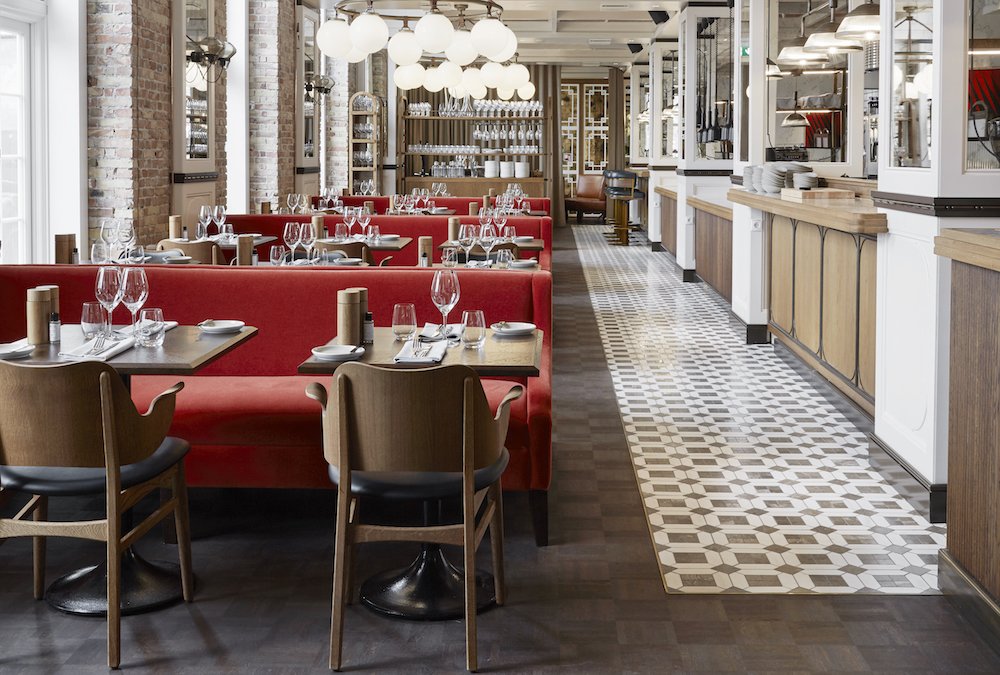
Image caption: Kontrast | Image credit: Stine Christiansen
Curved booth seats in warm brown leather tones are complimented with custom high chairs in striking hues that fill out the main dining area inside, allowing guests the chance to gaze into the large, open kitchen and bar. Bespoke tables are inlaid with brass, showcasing the level of craftsmanship and attention Epicurean brings to each fit-out, while also adding something new and fun to the traditional Scandinavian styling visitors might come to expect elsewhere in town.
On the terrace, overlooking the main station, more contemporary woven textile furniture sits outside, alongside Tore Gustafsson’s menu of fresh, local and seasonal produce. Taking inspiration from the south of Europe and North Africa, Gustafsson – known for previously steering the helm of Copenhagen Meatpacking favourite Paté Paté – has built an impressive sustainable food profile across all the F&B outlets, with a focus on providing a ‘carbon-free’ experience.
Sustainable hospitality solutions
Part of the overall commitment by the hotel to four of the UN Sustainable Development Goals – Decent Work and Economic Growth; Sustainable Cities and Communities; Responsible Consumption; and Production and Partnerships for the Goals – meat consumption at each outlet has been reduced, alongside overall food waste, with an innovative technology converting this into green energy. Fresh herbs and spices are also handpicked from the hidden rooftop garden, which sits next to a beehive from Bybi and the famed lapping pool.
F&B areas
Designed by Goddard Littlefair to reflect the local community’s relationship with food, drink and socialising, there are a plethora of options when it comes to F&B in the hotel. Breakfast is served daily in the former postage sorting room, Public, located on the lower floor which is accessed via a neon light-filled stairwell off The Courtyard. Descending into what feels like the belly of the grand building, you can hear the hum of the nearby train station, which provides a steady memory of its previous life.
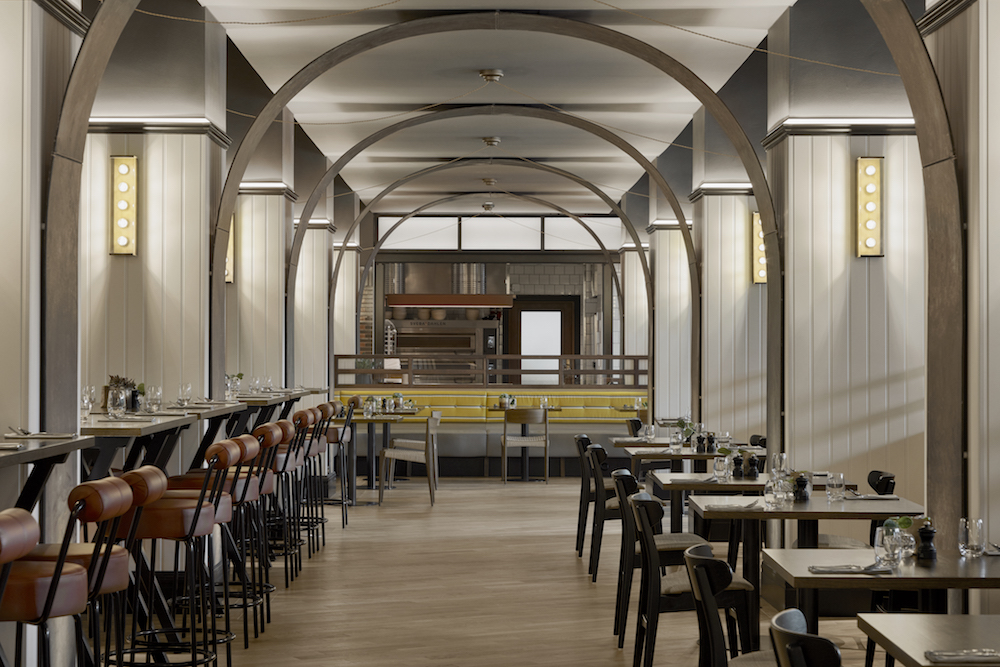
Image caption: Public | Image credit: Stine Christiansen
Indeed Epicurean drew heavily from archival photos of the space in its former glory, invoking its archways, lighting, brickwork and paneling in their redesign. The expansive area, filled with rows of bespoke banquette seating and commanding repurposed copper arches, can also host larger functions and groups and extends onto the sunken garden, containing the entrance to the almost completed Rug Bakery.
The original arrival point for the mail, the impressive terrace space is somewhat of a hidden gem for the hotel – exposed when the roof was removed from the loading dock – and a perfect place to enjoy the freshly baked local pastries Denmark is known for.
The guestrooms and suites
In contrast to the lively public and F&B areas, Universal took their starting point for the design of the guestrooms and suites from the art of Danish master painter Vilhelm Hammershøi – known for his understated composition, elegant lighting, muted palette and study of secluded moments and spaces.
Mapping out the building’s original interior, the studio restored and reinstalled many of the key period features like the impressive windows, herringbone flooring, cornices, architraves and wood paneling. Each room and suite has been treated like a grand Danish residence, housing a sophisticated collection of custom-designed classic and contemporary furniture, alongside original pieces from known Danish designers Hans Wegner, Finn Juhl, Nanna Ditzel, Niels Otto Møller, Ole Wanscher and Borge Morgensen. Warmth and softness is key, with bespoke textiles, lighting and ceramics amplifying the comfort to create a calm refuge with more than a few touches of brilliance. Materials are locally and sustainably sourced where possible, with Kvadrat’s Sahco brand providing natural wool textiles that sit next to other highlights including biodegradable and recyclable linen headboards produced by Scandinavian interior textile studio Astrid.
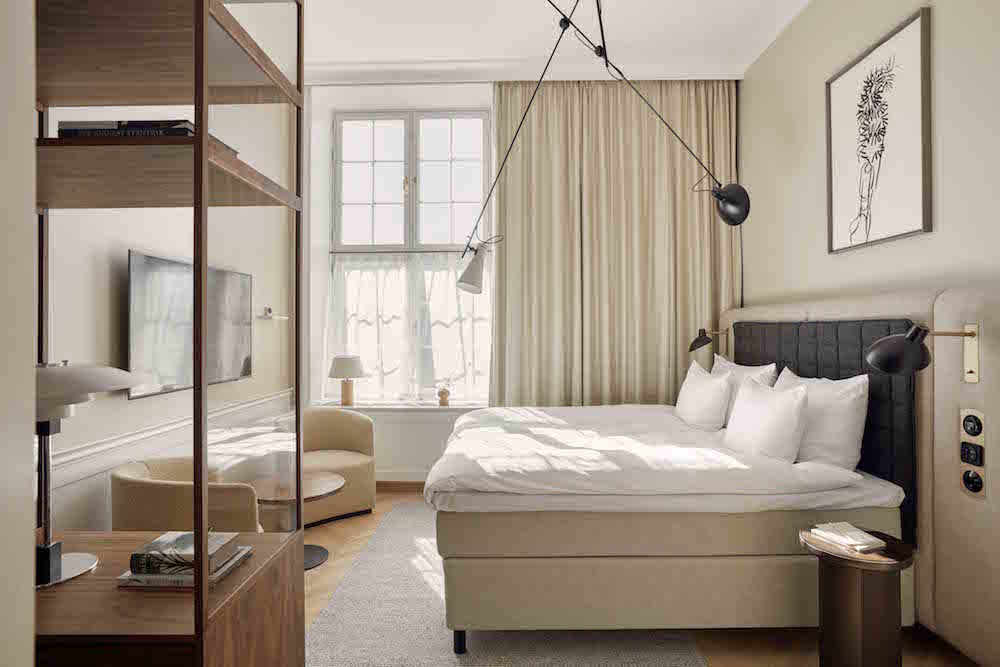
Image caption: Delux guestroom | Image credit: Villa Copenhagen
Each of the rooms has its own typography – there are 50 in total – with sprawling four metre-high ceilings on the lower levels and near floor-to-ceiling windows that give you various views of the city surrounds. The converted attic, with its exposed timber beams, differs only because of its unique character and obvious height limitations – but its roof-lit views of the city more than compensate for this.
Of course all the usual five-star modern conveniences apply, with keyless entry, remote check-in, virtual check-out, and an optional white glove service available in each of the 381 rooms. In-room facilities are on-point too, with a considered range of local favourites that includes Mikkeller beer and chocolate, Great Dane Rum, Nordic winegums, Harahorn Norwegian gin, and ELG vodka.
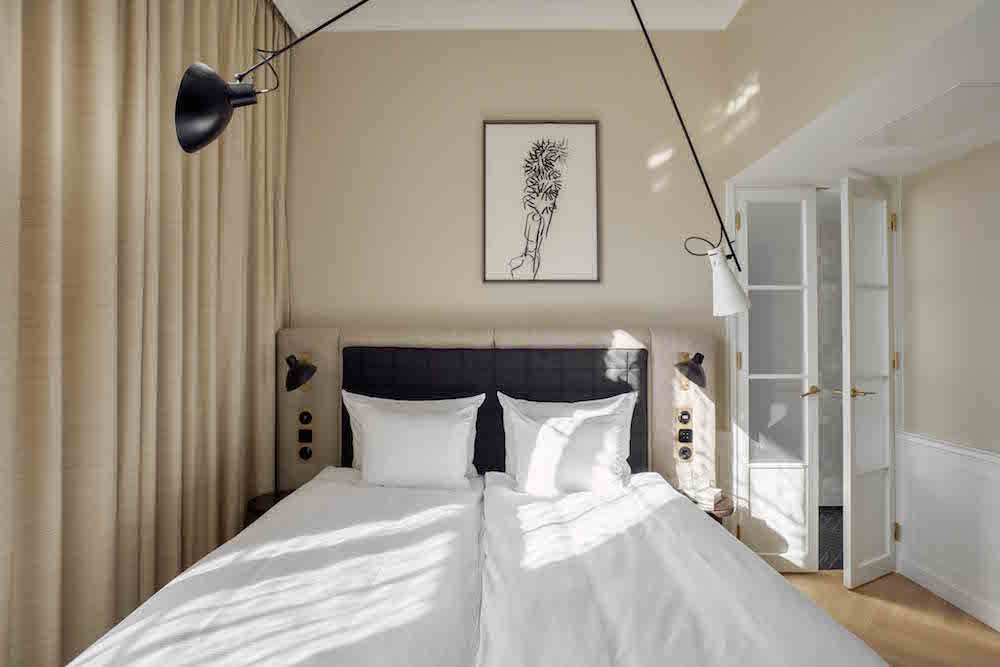
Image caption: Guestroom | Image credit: Villa Copenhagen
Sustainability stays top of mind, with custom in-room guest amenities provided by Skandinavisk in a signature range that pays homage to the smell of wood-laden northern forests. Gone are the plastic-wrapped pairs of slippers, replaced instead by slides that can be bought in the hotel’s boutique store, together with a collection of other local, sustainable and notable designers.
But if you really want to experience something different, then check-in to the ‘Universal Penthouse Suite’ which was designed across two floors with a central walnut and steel spiral staircase connecting the upper master bedroom with the lounge space on the lower floor.
- Image caption: Universal Penthouse Suite | Image credit: Villa Copenhagen
- Image caption: Universal Penthouse Suite | Image credit: Villa Copenhagen
Added to this next-level option is the completely sustainable suite, the Earth Suite, designed by Eva Harlou using eco-friendly furniture and recycled materials and textiles. Denmark’s most expensive suite, the Shamballa Master Suite was designed by Shamballa Jewels and takes in 110sqm that includes the former Postmaster’s office and the best view of the adjoining main station.
- Image caption: Earth Suite | Image credit: Villa Copenhagen
- Image caption: Earth Suite | Image credit: Villa Copenhagen
Sitting in a collection of seven other Shamballa suites, these exclusive retreats are due to be completed by the end of 2020 – a small casualty of the Covid-19 lockdowns.
Luckily though, if you can’t afford the additional extravagance of the Shamballa suites, the lapping pool, with its centralised cooling system using excess heat from the hotel to keep it at a steady 34 degree, provides a welcome space to relax and unwind. Adjacent to the 24-hour fitness centre, sauna and wellness area, it is a colourful, secluded spot that sits beside the rooftops of Copenhagen and offers a cabana service from its Pool Bar.
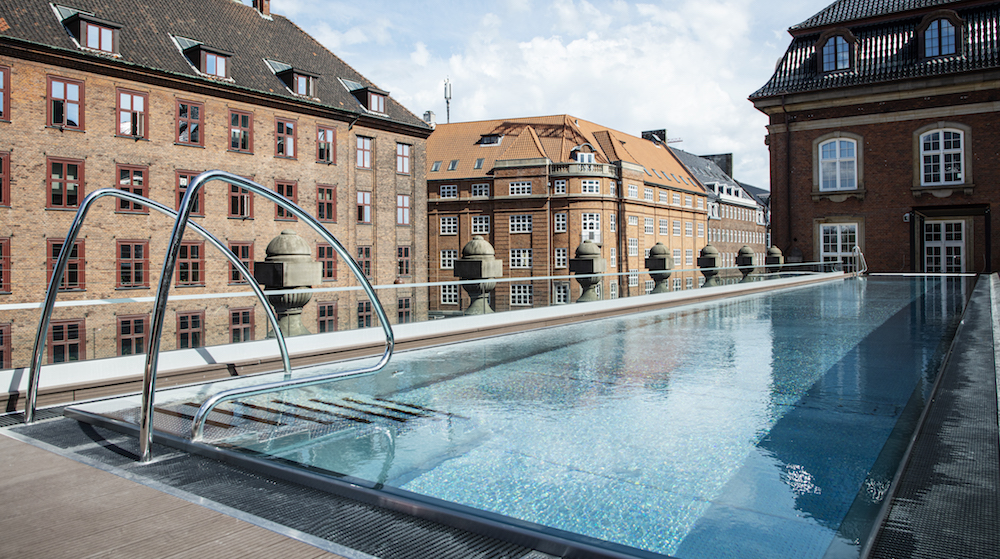
Image credit: Stine Christiansen
You might also like to take a walk through the five floors to check out the private collection of artwork – valued at more than US$2 million – that includes local and international artists like Per Kirkeby, Ian McKeever and Bent Stokke. Norwegian Stokke produced 383 unique charcoal artworks to be featured in each room, as well as along the many hallways and restored stairways.
But perhaps the real jewel of the hotel is the Old Boardroom, available to be hired as a private function space for intimate dinners and gatherings, and still proudly displaying the plaque bestowed to the building by both Kings Frederick III and Christian X who both ruled the year it was inaugurated. Its restored tapestry-and-chandelier adorned space, with adjoining bar, sits in stark, refined contrast to the other over 2,000sqm of meeting and event room spaces that are decorated with more than 850 conference chairs produced using 2.75kg of upcycled plastic ocean waste and fishing nets. It is just another example of how the hotel holds dual respect and reverence for the past and the future – carefully balancing respect for each in the present.
And like a home that becomes more of itself every day new memories are created within it, Villa Copenhagen, in all its imposing glory, is sure to become a welcomed part of the city’s new landscape: a reinvigorated icon that stands even taller than its predecessor.
Main image credit: Villa Copenhagen

